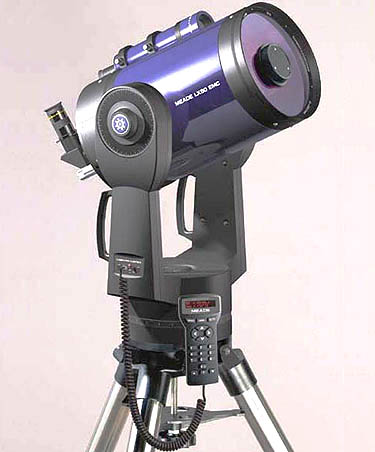Product Review: Meade LX90 SCT
Grant Barlow
Over the years I have had several telescopes. My first was a 1984 Celestron Super C8 SCT (Schmitt Cassegrain Telescope). I used that until 1992 when Two-Inchitis struck and I upgraded to a Coulter 17.5" Dob. As I had a slide-in camper in my truck, the size of my scope was dictated as to what would fit through the door. When I bought a new camper, the 17.5" would not fit, so I downsized to a Meade 12.5" Starfinder Dob. In 2001 I was without a scope. This past July, I got back into Astronomy, purchasing an 8" Meade LX90 SCT.

When my wife and I decided we wanted a telescope we could take camping, the quest began. What to Buy? After having two Dobs, I decided I was tired of "Star-Hopping" (sorry Jack) and wanted an automatic unit. Diane wanted something easy to use. Orion has nice scopes but nothing computerized. That left Celestron and Meade products. After searching their product lines, I decided I wanted the Meade LDX55 6" refractor. Using the Meade Dealer Locator, I discovered Shutan Camera had moved from downtown Chicago to Vernon Hills, and they had the LDX55 refractor in stock.
When Diane and I went to Shutan we were amazed by the amount of scopes they have on display. Shutan sells Celestron, Meade and TeleVue brands and they had about 20 scopes on the showroom floor. Their telescope expert is Neal and he knew the pros and cons for every scope and eyepiece he sells. He thought I wouldn't be pleased with the quality of the Meade LDX55 equatorial mount and it's auto-pointing ability (+/- 15 arcminutes vs. +/- 5 or better for the LX90/200) and directed us to the Celestron NexStar and Meade LX90/200 lines. The Celestron line of SCT's are less expensive than the comparable Meade, but have similar specifications. The major difference between the two is Celestron scopes cannot be used manually, that is they do not have any way to release the RA or Dec axis for star-hopping. That narrowed it to the Meade SCTs and price won out for the LX90, their "entry-level" GOTO scope.
The Meade scopes come delivered in a plain cardboard box with foam rings to hold the scope for shipping. This necessitates purchasing an aftermarket case. There's a hard case from JMI ($269.00), which brings the cost of the scope to $1940. + tax. A wedge is available for those needing an EQ mount for around $160 (I bought the wedge from a company on the Internet going out of business for $100). We also purchased an accessory tray (Easy Mount Plate - $105.) that attaches to the top of the tripod, supplying a larger surface when mounting the scope. With the auxiliary eyepieces and other sundry items the total came to around $2500.
It took approximately an hour to get everything unpacked and assembled. The finder scope (8x50) mounting rings attach to the scope via a dovetail slot and must be taken off for storage in the JMI case. First light came that very evening. Initial turn-on brings up a warning not to look at the sun; afterwards location data can be input. Each turn-on requires Date, Time, Daylight Savings, Location. For location, the actual latitude and longitude can be input or one can choose from various locations already in the AutoStar. The first time out I chose Chicago. After hitting Enter, the scope slewed to Arcturus and looking in the eyepiece, it was not there. Meade supplies a very nice finder scope and they do so for a reason: the scope cannot be aligned without it. Attaching the finder (I aligned the finder with the scope manually using the Moon) and starting over, Arcturus was easily found in the finder, centered, entered and the scope slewed to Altair. After centering and entering, the handset "beeped" and indicated alignment was successful.
On that night of first use, the Moon was nearly full, so along with the ever-present skyglow, Deep Sky object were not going to be very bright. For this first viewing session, I decided to give it the "Extreme Viewing" test - slewing from east to west and back. Each object I asked it to find was quickly and accurately centered in the eyepiece. The brighter objects, such as M57 and M13 were clear and sharp. Objects such as M15, M81 and M82 were just "faint fuzzies". Optically, the Meade LX90 is the same as all the other 8" SCT's. What makes this scope is it's excellent software and pointing abilities. I believe I made the right choice, considering my current viewing objectives.
This past month I purchased the StarGPS, an aftermarket GPS from Pixsoft ($169.00 (www.stargps.ca)). StarGPS comes with an Autostar to computer serial cable, the GPS unit, and 2 program CD ROMs. In order to install GPS on the LX90, the hand unit has to be connected to a computer and the computer has to be connected to the Internet. Installation was simple and took about 10 minutes. The instructions recommend inputting NO for Daylight Savings. This enables the GPS to use GMT instead of converting to local time. Setup of the telescope proceeds as normal with the exception of not needing any inputs for local time or location.
While this telescope fits my needs, I would not recommend it for someone looking to purchase their first scope, mainly because of the price. GOTO telescopes require some knowledge of the night sky and astronomy. For those ready to move up from the 4 1/2 or 6", this would be something to consider.
Published in the November 2003 issue of the NightTimes




